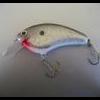If you're going to use the rod for crankbaits, spinnerbaits, jerkbaits, or other moving presentations, all rods will be tip heavy due to the resistance of the lures being retrieved. Some tip-heaviness can actually be good. It helps casting and can help when jerking jerkbaits. Virtually all fiberglass crankbait rods are tip-heavy due to the material used in the blank. It's not a detriment because the rod will be tip-heavy anyway during the retrieve.
The case where tip-heaviness really matters, IMO, is for "still presentations" like jigs, worms, C-rigs. It is virtually impossible to find any rod at any price that is not somewhat tip-heavy and the longer the rod, the more tip-heavy it will be. So we're really talking about the degree of tip-heaviness rather than its absence. Clamp on your reel. Hold the rig the way you do when fishing a worm. The more weight you feel out front, the more tip-heavy the rod is. It's like picking up a brick and holding it at arm's length. Easy enough to do, right? Do it for an hour and see how you feel. It runs against the grain to take a $250 rod blank that weighs 2 oz and stuff lead in the butt to balance it. You paid big bucks just to get a light sensitive rod blank. And maybe it does reduce ability of the rod blank to transmit vibration (i.e. its laboratory sensitivity). If Gary Loomis says so, I believe him. But there is a difference between laboratory sensitivity and on-the-water sensitivity. What you really want is a rod that allows to sense bites all day long. Somewhat like the "brick" example, holding a worm rod that is tip heavy by an ounce all day long will cause the fine muscles in your hand to fatigue - and that reduces your ability to sense bites. So I wouldn't hesitate to butt weight a worm rod, and especially a moderate cost worm rod which I would expect to be more tip heavy anyway. I agonize over butt weighting a St Croix LE. Usually not - at least until I've used it awhile and come to my senses.





